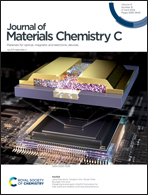Two-dimensional molecular moiré superlattices of tryptophan with visible photoluminescence for photo-activatable CO2 sensing and storage†
Abstract
Moiré superlattices of simple molecules can showcase new physical and chemical properties through interactions at crystal interfaces, which could be termed as hypermolecular interactions. We report the formation of moiré superlattices of L or D tryptophan (trp) molecules in an aqueous medium. A strong photoluminescence peak at 452 nm and an additional peak at 500 nm were observed. Transmission emission microscopy investigations revealed the formation of moiré superlattices with low-angle twisted hexagonal crystalline nanosheets of trp as units. The atomic force microscopy measurements of force–distance curves indicated van der Waals interactions typical of soft matter. The results can be accounted to the 25–30° helical stacking of 2D molecular crystals of trp, where a new interfacial interaction provided extraordinary stability to the superlattices. The superlattices were also found to have superior chemical stability under alkaline conditions compared to crystalline films. These molecular superlattices were useful for CO2 sensing as well as storage, which was more efficient following exposure to UV light.



 Please wait while we load your content...
Please wait while we load your content...